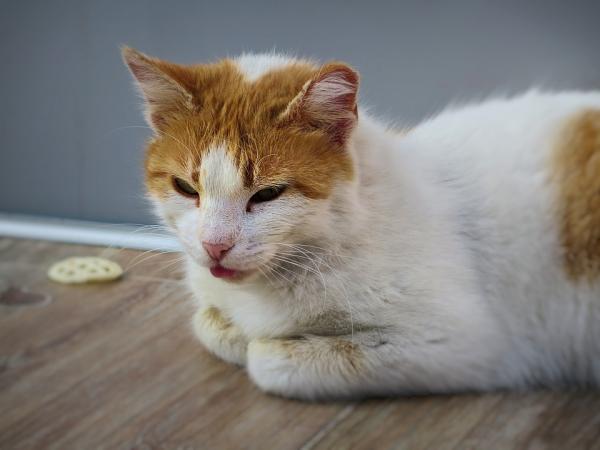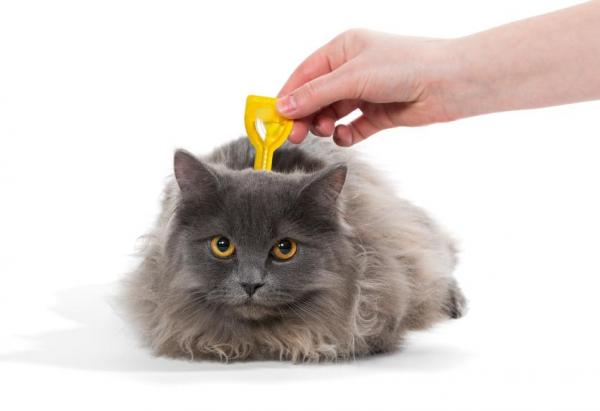Feliary miliary dermatitis – Symptoms and treatment

Surely the lovers of the cats have surprised you ever pet your cat, and notice small pimples on your skin. You may not even have noticed, or at other times, its appearance is so obvious and alarming that it has brought you to the vet.
In this article, we will try to summarize in a simple way the origin of the feline miliary dermatitis, the symptoms it presents and the treatment to follow, apart from other advice, keep reading:
What exactly is feline miliary dermatitis?
Miliary dermatitis is a sign common in many pathologies. To be able to compare it, it is equivalent to saying that a person has a “cough”. The origin of the cough can be multiple and may even have nothing to do with the respiratory system, the same happens with feline miliary dermatitis.
The terms “Miliary dermatitis“Refer to the appearance on the skin of a cat variable number of pustules and scabs. That is to say, it is a skin rash, frequent especially in the head, neck and back, but it is also quite frequent in the abdomen and we can observe it when shaving said area.
In general, many appear and are small, which is why the word “miliary” Although we have not realized (because the cat can live outdoors) is almost always accompanied by itching (itching), which in fact, is directly responsible for the manifestation of that eruption.
The most common causes of miliary dermatitis:
- Parasites (mites in ears, mites of nooedric mange, lice.)
- Allergic dermatitis to the flea bite (DAPP)
- Atopic dermatitis (can be defined as a generalized allergy, from dust mite to pollen, through various materials)
- Food allergies (allergy to a component of feed)

External parasites as cause
The most common is that our cat has a parasite that causes pruritus, and the scratching causes the rash that we know as miliary dermatitis. Here we offer a small summary of the most common:
- Mites of the ears (Otodectes cynotis): This small albino mite, lives in the ears of cats, causing great itching with its activity. It usually leads to the appearance of miliary dermatitis in the neck and around the auricle, even in the area of the neck.
- Mite of nooedric mange (Notoedres cati): A cousin the mite of sarcoptic mange of the dog, but in feline version. They usually call it “the scabies mite of the head”, since in initial stages, lesions are usually seen in ears, skin of the neck, nasal plane. The skin becomes thickened considerably by continuous scratching. You can expand a little information about this disease in the article on scabies in cats.
- Lice: It is very common to see them in cat colonies. Its sting (they feed on blood), causes again a pruritus that the cat tries to calm with scratching. And from there, the eruption arises, which we refer to as miliary dermatitis.
What treatment should the cat follow?
These external parasites respond to the application of selamectin topically (on undamaged skin), or systemically (eg, subcutaneous ivermectin). Today we find in the market enough pipettes containing selamectin and also otic preparations to be applied directly to the ears based on ivermectin.
Of course, as in almost all acaricide treatments, it has to be repeated after 14 days, and a third dose may even be necessary. In the case of lice, fipronil applied every so often several times is usually quite effective.

The allergy to flea bite as a cause
One of the most frequent allergies, which results in miliary dermatitis, is the allergy to the flea bite. These parasites they inject an anticoagulant to be able to suck the blood of the cat, and to him precisely, they have allergy a considerable number of felines.
Even after all the fleas have been eliminated, this allergen is still present in the cat’s organism, causing itching even though the responsible ones have been eliminated (actually a single flea, already serves to trigger the process if the cat is allergic, but to more fleas , the miliary dermatitis is more severe usually.
The treatment of allergy to flea bites as a cause of miliary dermatitis is quite simple: we must exterminate fleas. There are effective pipettes that repel the insect before it can feed.

Atopic dermatitis as a cause
It is complex to define atopy. We will refer to it as the process in which the cat is allergic to various things and this generates the inevitable itching, which is associated with these crusts and pustules that we call miliary dermatitis.
Treating it is almost more complex than diagnosing or defining it, being necessary to resort to corticosteroid therapy and other coadjuvant treatments that lend a hand, although by themselves they do not do much), such as polyunsaturated fatty acids.

Food allergies as a cause
Each time it is seen more frequently, but perhaps it is because we are increasingly concerned about our cats and attend to things that were not repaired before.
Many times there is no trace of fleas, or parasites, but our cat scratches in a continuous way, causing this miliary dermatitis, which, as in the previous cases, can be contaminated and lead to a more or less serious infection.
It is not a rule, but the itching usually appears in the anterior part (head and neck) and over time, it is usually generalized. It is frustrating, because corticosteroid therapy is often tried but it does not give the expected result. It may scratch less a few days, but no clear improvement is observed. Until the previous diet the cat has taken is completely eliminated, and 4-5 is tested for weeks with a I think hypoallergenic and water, exclusively.
In the second week we will notice that the miliary dermatitis is receding, the pruritus is milder, and the fourth, has practically disappeared. Reintroduce the previous diet to check that in two days the cat scratches again, it is the definitive way to diagnose it, but almost no veterinarian considers it necessary.
Many other causes of miliary dermatitis in cats are left in the pipeline (pyoderma, that is, superficial skin infections, autoimmune diseases of difficult names, other external parasites besides those mentioned, etc.) but the intention of this article is to highlight that miliary dermatitis is simply a symptom common to innumerable causes, and that until the cause is eliminated, the dermatitis will not disappear.

This article is merely informative, in .com we do not have the faculty to prescribe veterinary treatments or make any kind of diagnosis. We invite you to take your pet to the veterinarian in case of any type of condition or discomfort.
If you want to read more articles similar to Feliary miliary dermatitis – Symptoms and treatment, we recommend that you enter in our section of Other health problems.


